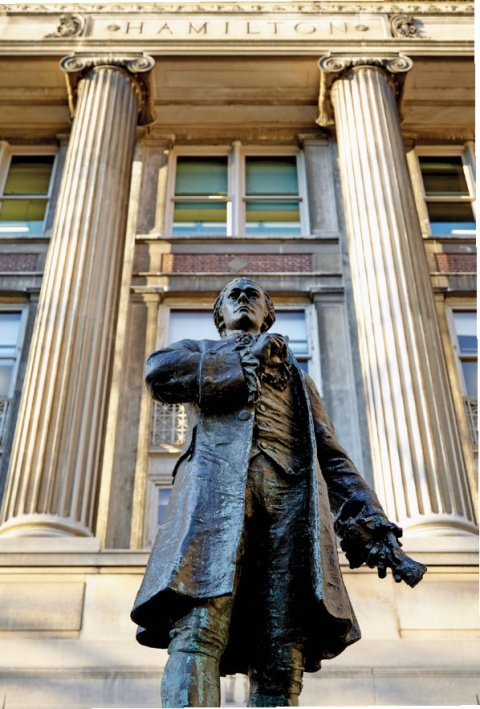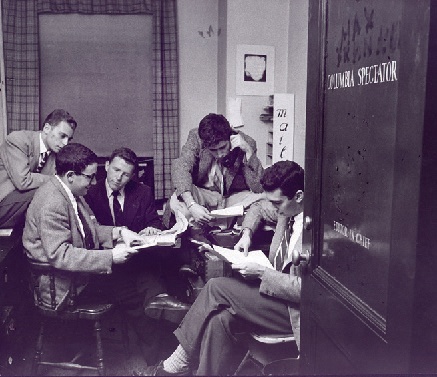Columbia College | Columbia University in the City of New York
Letters to the Editor
President Hamilton?

FRANCIS CATANIA
Being both a College grad and a resident of Hamilton County, Ohio, I am interested in Alexander Hamilton (Class of 1778). I found an error in the Fall 2015 “Alumni Corner” by Bob Orkand ’58. He states that, due to his birth in the West Indies, Hamilton was ineligible to be President. That is not really true. Article 2, Section 1, Clause 5 of the U.S. Constitution states: “No Person except a natural born Citizen, or a Citizen of the United States, at the time of the Adoption of this Constitution, shall be eligible to the Office of President; neither shall any person be eligible to that Office who shall not have attained to the Age of thirty five Years, and been fourteen Years a Resident within the United States.”
Hamilton truly was a citizen at the time of the adoption of the Constitution, so he would have been eligible (even had he not supplied his long-form State of Hawaii birth certificate).
As an aside, several, including this article’s author, think that instead of replacing Hamilton on the $10 bill we should replace Andrew Jackson on the $20 bill. As a College grad I have an affection for Hamilton but I am also a graduate of Andrew Jackson H.S., so I shall remain neutral.
Barry Austern ’63
Cincinnati
In his brief essay on Alexander Hamilton (Class of 1778) and the $10 bill (“Alumni Corner,” Fall 2015), Bob Orkand ’58 repeats a common error regarding Hamilton and his eligibility to run for President. Article 2, Section 1, Clause 5 of the U.S. Constitution clearly says: “No Person except a natural born Citizen, or a Citizen of the United States, at the time of the Adoption of this Constitution” is eligible for the presidency. Or is he claiming Hamilton served in the Revolution as Washington’s chief aide, and as secretary of the Treasury, while being a foreigner?
I find it suspicious that the current secretary of the Treasury wants to remove a firm opponent of slavery, who founded New York’s first anti-slavery society, while leaving intact three slaveholders (Washington, $1 bill; Jefferson, $2 bill; Jackson, $20 bill). Jackson in particular should be removed as a probable bigamist, scorner of Supreme Court rulings and initiator of genocide.
Thomas Wm. Hamilton ’60
Staten Island, N.Y.
(Editor’s note: CCT reached out to Columbia faculty for clarification and received the following from Herb Sloan, professor emeritus at Barnard, whose teaching interests are history of the Colonial and Revolutionary periods, and the history of American law, including the Constitution:
“Hamilton was definitely eligible to serve as President under the ‘citizen at the time of the adoption of the Constitution’ rule. (You might note that all of the presidents before Van Buren were born British subjects and were not natural-born citizens.) I cannot tell you precisely how he became a citizen of New York, but I assume it was by virtue of being there at the time — which is how he and everyone else became U.S. citizens under the Constitution ... there was no formal process, no paperwork, etc.”)
Don’t Stop the Music
Great to read about the wonderful piano stylist Dick Hyman ’48 [CC’48 Class Notes, Fall 2015], who continues to pack them in at concerts in the United States, Canada and everywhere. I knew Dick as the composer for the Varsity Show, April 1946. I was part of the all-male chorus line — after daily rowing practice on the Harlem River (I was coxswain at 115 lbs.). Tell Dick to keep it up, make more fingers snap and make more records!
Dr. Joseph P. Rumage ’47
Kenner, La.
Putting Names to Faces
The Fall 2015 issue, page 49, features a photo with the caption “New students mingle on Low Steps in 1957.” Fourteen freshmen (wearing freshman beanies) are shown with an older gentleman in a dark suit.
Who are these anonymous students? All freshmen in the Class of 1961, presumably. Of the five students sitting in the first row, I can identify three for certain. Second from the right is Alvin Schifrin ’61, in the middle next to him is David Blicker ’61 and next to Dave and second from left is Matthew Chamlin ’61, BUS’64 — that’s me! Some of the other faces look vaguely familiar but I haven’t a clue as to who they are.
Alvin was a roommate of mine and I believe still practices law in California. Dave passed away in 2012 and his life and untimely death were noted in CCT. After graduating from the Business School, I was president of nine consumer product companies and am now retired. My only connection with Columbia these days is occasionally auditing courses at the Business School and attending lectures and other events at the Harriman Institute.
I don’t recall ever seeing this picture before and dating from what was probably our first week of our freshman year in 1957, it is a bit of an historical relic. Nice to see it!
I wonder what other treasures from Columbia’s past are stored in the University Archives?
Matt Chamlin ’61, BUS’64
New York City
Teddy Roosevelt’s View
Loved the Fall 2015 issue, especially the “Columbia Forum” on TR’s house. But please tell me how it is possible to see the Hudson from the back porch in Oyster Bay, N.Y., as stated on page 29? Long Island Sound, yes; Hudson, no.
Allen Breslow ’61, LAW ’64
Old Bethpage, N.Y.
I was enjoying Adam Van Doren ’84, GSAPP’89’s “The House Tells the Story” (“Columbia Forum,” Fall 2015) until the fatal moment the author stepped onto the back porch and experienced its sweeping view of the Hudson River. Had he been describing FDR’s home at Hyde Park, all would have been well. Alas, he was writing about TR’s beloved Sagamore Hill, firmly anchored above Oyster Bay, Long Island Sound. This geographical absurdity had passed neutrino-like through the scrutiny of historian David McCullough, the editors of David B. Godine, Publishers, and ultimately the editors of CCT. I conjure the ghosts of Van Doren’s distinguished ancestors, Carl (Class of 1911 GSAS) and Mark GSAS’21, who would caution the House of Intellect is vulnerable as was the fabled kingdom of olde to perishing for want of a horseshoe nail.
Tony O’Keefe ’59
Port Chester, N.Y.
(Editor’s note: Van Doren reports that the error has been corrected in the book’s second edition, which recently went to press.)
Correction

COURTESY COLUMBIA UNIVERSITY ARCHIVES
A photo of students in the Spectator office (Summer 2015, page 57) was incorrectly captioned. The students are, left to right: Dr. Larry Gartner ’54; Lawrence Kobrin ’54, LAW’57; Dr. Larry Scharer ’54, PS’58; Judah Berger ’54; and Michael R. Naver ’54. All were members of the 1953–54 Spectatormanaging board. Board members not pictured included Charles Selinske ’54; Bernd Brecher ’54, JRN’55; and Richard Werksman ’54, LAW’58. CCT apologizes for the error, and thanks Kobrin and Naver for bringing it to our attention.
Issue Contents
Published three times a year by Columbia College for alumni, students, faculty, parents and friends.
Columbia Alumni Center
622 W. 113th St., MC 4530, 6th Fl.
New York, NY 10025
212-851-7852
cct@columbia.edu
Columbia Alumni Center
622 W. 113th St., MC 4530, 4th Fl.
New York, NY 10025
212-851-7488
ccalumni@columbia.edu

